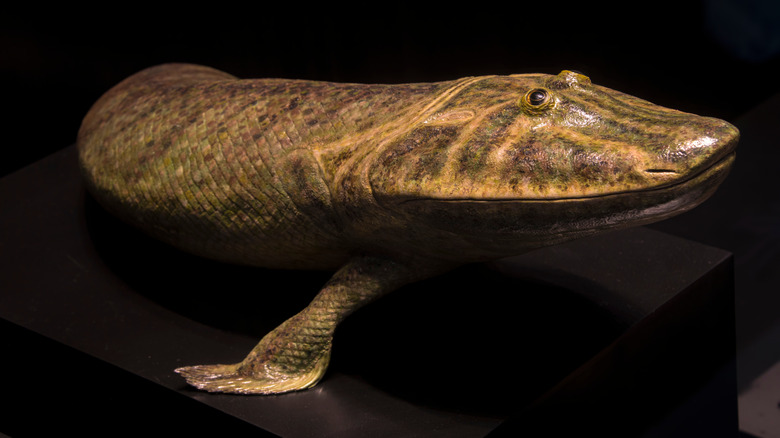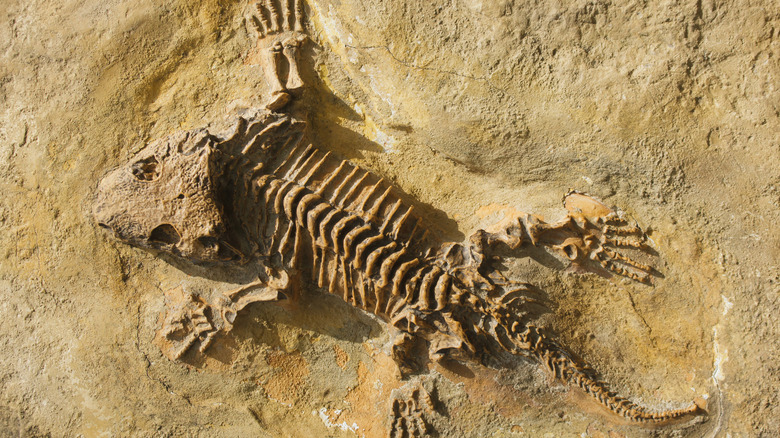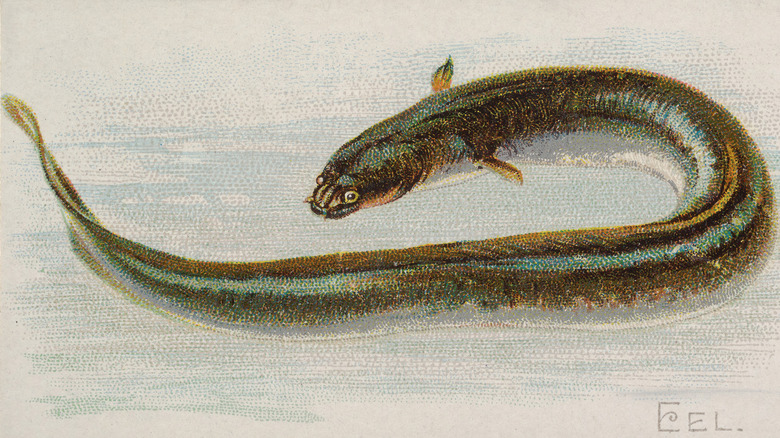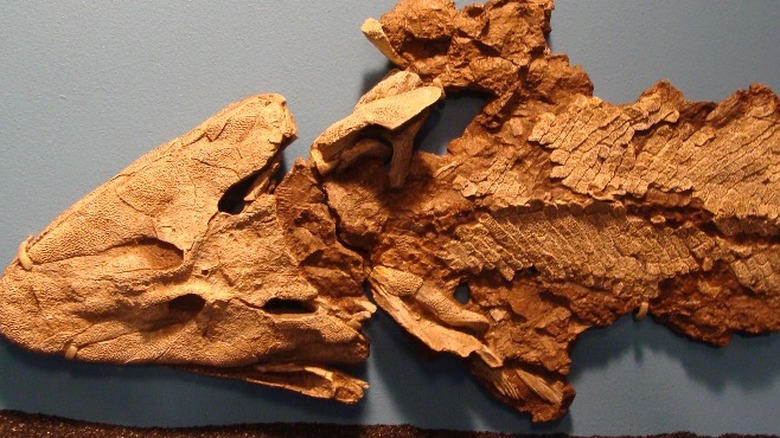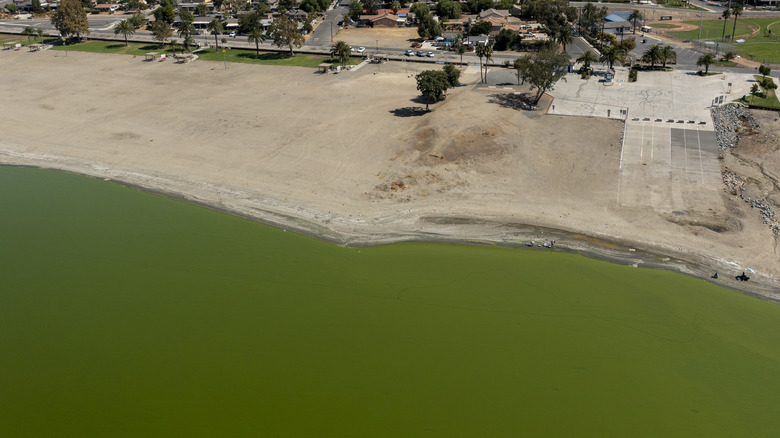Scientists Believe This Was The First Animal To Walk On Land
Before creatures walked the land, they swam in the water. Why transition from cool, crisp seas to the terra firma some 385 million years ago, exchanging gills for lungs and fins for legs in the process? There are a few theories. Research posted at the Proceedings of the National Academy Of Sciences of the United States of America (PNAS), led by Malcolm MacIver, a professor of biomedical and mechanical engineering at Northwestern University, for instance, suggested that vertebrates wanted to stretch their view more than just scamper around. On land, prey became easier to see, creating something the scientists dubbed as the "informational zip line." This benefit encouraged animals to develop in an adaptive way in order to breach the land, so they could reach all those tasty and desirable new food sources.
The process took millions of years, with only certain fish evolving, as their eyes tripled in size and gravitated from the side of the body to the head area. Eventually, such vertebrates resembled crocodiles, peering at the world from the water's surface. As eye size increased, so did the animal's view — and, perhaps, its desire to explore. MacIver and his colleagues proposed in their "buena vista" hypothesis that this better vantage point propelled development that enabled fish to become land animals, eventually gaining limbs and the rest which allowed them to change habitats. "It's hard to look past limbs and think that maybe information, which doesn't fossilize well, is really what brought us onto land," MacIver said in Quanta Magazine. But there are other theories floating around about how the movement from sea to land happened.
How did fins become legs?
Most theories about how animals crept from the water to explore the earth involve the transformation of fins to legs. "One early theory suggested that the climate was changing and becoming drier, and that early tetrapods" — four-footed animals — "evolved limbs to move from one body of water to the next," said paleontologist Lars Schmitz to Earth Magazine.
The Department of Organismic & Evolutionary Biology at Harvard University corroborated that as water evaporated, fish needed to adapt to their new surroundings in order to live. So, they grew limbs that enabled them to find other pools of water, and some learned to live successfully on land. Some theories proposed that the first tetrapods actually kept their gills and fins as their legs formed, even though they still lived in water. Research published in Nature, for instance, suggested that a hybrid evolution was possible, with the earliest vertebrates moving back and forth from watery and terrestrial environments again and again. Researchers surmise that movement on land was initially limited to short journeys before heading back home. The scientists examined 40 models of fossil upper arm bones, or humeri, to support their hypothesis. "Because the fossil record of the transition to land in tetrapods is so poor we went to a source of fossils that could better represent the entirety of the transition all the way from being a completely aquatic fish to a fully terrestrial tetrapod," explained lead author Blake Dickson on the Harvard website.
Evolution never stops
The development of fish moving to land took millions of years, reported Awesome Ocean. Even after amphibians, reptiles, birds, and mammals entered the world, fish continued evolving. In fact, a study published in Evolution: International Journal of Organic Evolution (posted at Wiley Online Library) by scientists Terry Ord and Georgina Cooke of the University of New South Wales, Australia, hypothesizes that fish may have changed repeatedly, perhaps more than 30 times.
Their 2016 work discusses 130 types of fish and marine life that can live on land at least part-time — some for days — using arm-like appendages for movement and lungs to process air. Some of the examples they looked at include the American eel, which can move from pond to pond after a rainfall; the longspined sea scorpion, that also journeys between one tide pool to another; and the Atlantic mudskipper, that scurries amid mudflats. Blennies, a coastal fish that uses a sort of suction-cup fin to remain on rocks in the water, even transitioned to land several times. "It's fascinating that ... these transitions may not be as difficult as presumed," said Sandy Kawano, a comparative biomechanist at the National Institute for Mathematical and Biological Synthesis in Knoxville, Tennessee, to Science.
"These forays onto land have occurred in fish that live in different climates, eat different diets and live in a range of aquatic environments, from freshwater rivers to the ocean," added Ord in a statement from the University of New South Wales, Sydney, Australia. "While many species only spend a short time out of water, others, like mudskippers and some eels can last for hours or days."
A fossil find changes everything
Which was the first fish to make the plunge from water to land? Evidence is inconclusive, but through fossils, scientists can see moments of that journey through the remains of Tiktaalik roseae, reported The Guardian. The freshwater animal fused characteristics found in land and aquatic life, including gills, scales, fins, and lungs, and featured a head similar to a crocodile's. The creature, which measured about nine feet, was a hybrid, both fish and a four-legged early vertebrate.
Scientists first discovered the ancient animal in 2004 on a research trip to the Canadian Arctic. Right away, its structure amazed: a large pelvis, hip joint, and strong fins that allowed the creature to move in water as well as scamper on land. "To give you a sense of how giant it is, the pelvis of this animal is the same size as the shoulder, so it's very clear from understanding these bones that the hind appendage was already being emphasized in the transition to creatures with limbs," as Neil Shubin, a professor at the University of Chicago and one of the discoverers of Tiktaalik, told The Guardian.
Finding several Tiktaalik specimens on Ellesmere Island altered the discussion on how fish became tetrapods, said Shubin, lead author of the paper "Pelvic girdle and fin on Tiktaalik roseae" (also posted at PNAS). Prior information on how marine animals transitioned to land typically indicated that the hind fins became larger and stronger as the new breeds moved about the earth. But this discovery showed otherwise.
Why the Tiktaalik roseae is so important
Previous theories had suggested that hind limbs had only developed as animals adapted to life in their more earthbound environment, said Science Daily. This "front-wheel drive" hypothesis purported that fish moved primarily through fins located at the front part of their body, and tetrapods didn't become land dwellers until their skeletal structure could maintain "four-wheel drive" motion supported by a strong pelvis and hind limbs, said the study in PNAS. Something, scientists thought, happened on land. "It turns out that the size of the hind appendage was already large in fish and that a good chunk of the transition has already happened in fish before the origin of tetrapods," explained Shubin to The Guardian.
The animal's transition to land was always credited to development of these back legs, but the work of Shubin and his colleagues showed that this change actually occurred while the Tiktaalik still lived primarily in water. "Despite this, the girdles still show several fish-like characteristics," said Zerina Johanson, a vertebrate palaeontologist at London's Natural History Museum, to The Guardian. "The Tiktaalik pelvis is a mix of fish and tetrapod characteristics, showing that the transition from water to land is not as straightforward as we previously thought, and that some tetrapod characteristics thought to be linked to the movement onto land first evolved in fishes. This also suggests that the evolution of these characteristics occurred in a series of steps, the full nature of which we still don't fully understand."
Some fish really prefer water
While some fish moved to land, other four-legged fishapod creatures preferred to stay in the water. A 2022 article in Nature by lead writer Thomas A. Stewart and others, including Shubin, discuss why Qikiqtania wakei, a 30-inch animal similar to the Tiktaalik, probably returned to its marine environment. Qikiqtania's remains were actually found days prior to Tiktaalik's fossils, but stayed in storage for more than a decade while scientists continued examining the Tiktaalik discovery.
"At first we thought it could be a juvenile Tiktaalik, because it was smaller and maybe some of those processes hadn't developed yet," Shubin said in a news release from the University of Chicago. "But the humerus is smooth and boomerang-shaped, and it doesn't have the elements that would support it pushing up on land. It's remarkable different and suggests something new."
While Qikiqtania's fin allowed it to swim smoothly through the water, its body structure was more than a fish's. The animal had a distinct paddle-shaped adaptation that wasn't quite a leg, but seemed more than a fin. "Tiktaalik is often treated as a transitional animal because it's easy to see the stepwise pattern of changes from life in the water to life on land. But we know that in evolution things aren't always so simple," said Stewart. "We don't often get glimpses into this part of vertebrate history. Now we're starting to uncover that diversity and to get a sense of the ... unique adaptations of these animals. It's more than simple transformation."
